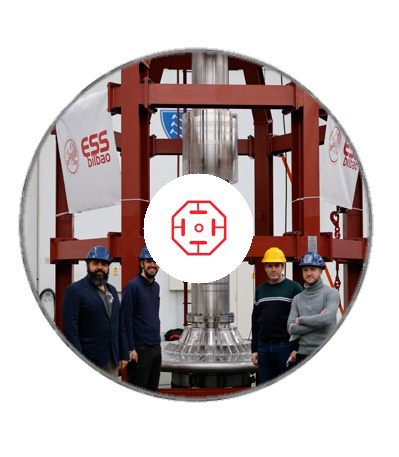Proton Beam Window
The PBW (Proton Beam Window) is the device in charge to separate the ultra-high vacuum atmosphere of the accelerator, to the rough vacuum atmosphere present at target side. A thorough design permits a 5MW proton beam to cross two thin plates of less than 1.25mm without suffering more than 1% of scattering (perturbation of beam features).
Nuclear calculations have been applied to study the material, its lifetime and property changes, and to obtain volumetric heat sources. Combined CFD and FEM analyses have been used to design an efficient cooling system, studying from the boundary layer effects, up to the design of a mechanical shape capable to support a nominal 5 bar absolute pressure within the slim plates, and maximum of 12.5 bar.
Manufacturing design has been performed; and milling, EDM and WEDM, have turned the already finished first prototype a great success, avoiding hazardous welds and preserving Al6061 properties in the whole bulk.
A remote operated seal prototype is currently under manufacturing design, and will enable to close both atmospheres by means of a pneumatic system. A helical design in steel shielding blocks will be used to avoid high levels of radiation leakages (streaming), while providing a stable solution to a restrictive envisaged vertical assembling process and gravity loads.
Mechanical Analyses
Mechanical Analyses
Mechanical Analyses

Prototiping and Testing
The high power deposited by the beam requires the use of thin volumes together with an aggressive cooling system. Ultimate manufacturing techniques are employed to solve such challenging designs, and the need of prototyping to learn from the process comes out.
There have been prototyped 4 models for the PBW, testing from the impurities in the material, the manufacturing repeatability, to the mechanical resistance by carrying out hydrostatic tests.
A 2.00 mm channel serves the 5 bar pressure coolant to remove the around 4kW deposited in the PBW, where 2 thin walls of 1.25mm comprises both sides of the structural part, forming a sandwich structure that we have found to be the most efficient from the thermal and mechanical points of view.
Manufactured prototypes
LPI, Ultrasonic and hydrostatic tests
LPI, Ultrasonic and hydrostatic tests
High radiation environment forces to perform completely remote handling operations. Sealing the region that enfolds the PBW is one of the most difficult challenges. A prototype for the seal has been manufactured, and a full testing sequence has been designed to investigate all possible situations in the final facility at Lund.
Remote handling design will permit us to insert and close the seal with no human interaction, avoiding the hazardous radioactive atmosphere, and guaranteeing precision of movement and positioning under 0.5 mm; all under full design at ESS Bilbao.
Remote handling seal prototype
Remote handling seal prototype
Different companies are already involved during the design, manufacturing and testing tasks, providing an excellent feedback that will support the final contribution to this project.




